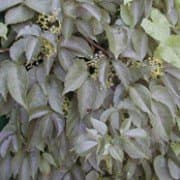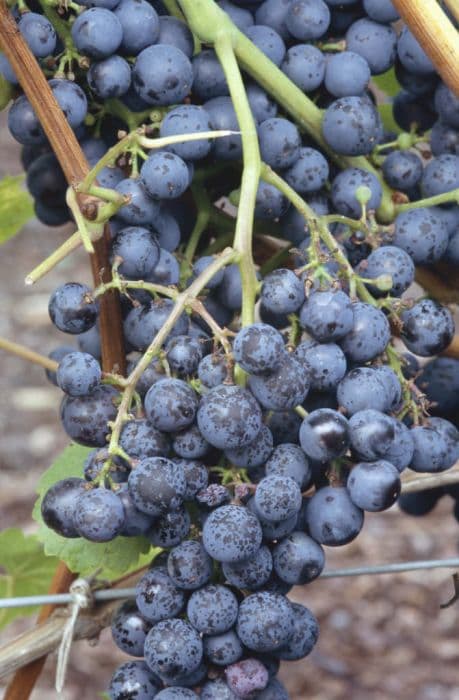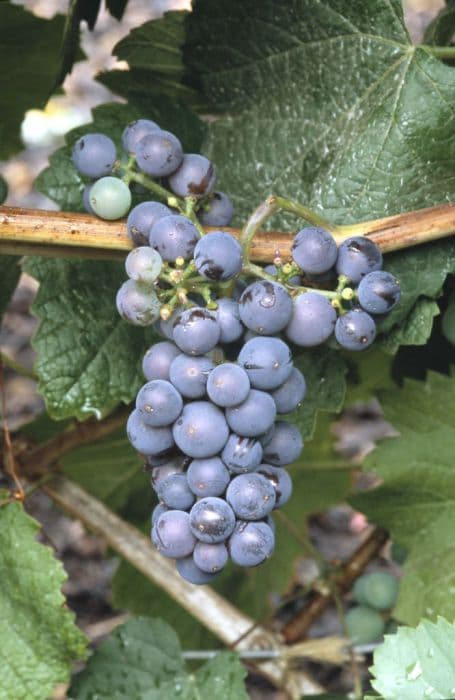Grape 'Pinot Blanc' Vitis vinifera 'Pinot Blanc' (O/w)

ABOUT
'Pinot Blanc' is a self-fertile, white wine grape suitable for outdoor cultivation producing seeded, mid-seasonfruit
About this plant
 Names
NamesFamily
Vitaceae
Synonyms
Pinot Blanc, Pinot Bianco, Pinot Bianchetto, Clevner, Weißburgunder
Common names
Vitis vinifera 'Pinot Bianco', Vitis vinifera 'Weißer Burgunder', Vitis vinifera 'Klevner'.
 Characteristics
CharacteristicsLife cycle
Perennials
Foliage type
Deciduous
Color of leaves
Green
Flower color
Varies
Height
15 feet (4.57 meters)
Spread
10 feet (3.05 meters)
Plant type
Climber
Hardiness zones
7
Native area
Europe
Benefits
 General Benefits
General Benefits- Economic Value: Pinot Blanc is a popular grape variety used for making white wines, contributing to the economy through viticulture and the wine industry.
- Aesthetic Appeal: The vineyards of Pinot Blanc are visually appealing landscapes that enhance the beauty of agricultural areas.
- Habitat for Wildlife: Vineyards can provide a habitat for a variety of wildlife, offering shelter and food for insects and birds.
- Pollination Support: The flowers can attract bees and other pollinators, playing a role in the local pollination of plants.
- Local Climate Moderation: Vineyards can help moderate local microclimates through transpiration and providing shade.
- Educational Opportunities: Pinot Blanc vineyards can be used for educational tours and wine tasting events, which can teach people about viticulture and enology.
- Cultural Significance: The cultivation and production of Pinot Blanc wines are often part of local traditions and cultural heritage.
- Socioeconomic Engagement: Wine production from Pinot Blanc can foster community development through job creation and tourism.
 Medical Properties
Medical PropertiesThis plant is not used for medical purposes.
 Air-purifying Qualities
Air-purifying QualitiesThis plant is not specifically known for air purifying qualities.
 Other Uses
Other Uses- Vitis vinifera 'Pinot Blanc', commonly known as Pinot Blanc, can be used to create vinegars. The acidic qualities of the wine produced provide a distinct flavor profile to vinegar.
- The grape skins of Pinot Blanc may be repurposed into natural dyes, providing a range of colors from light green to deep purple based on the processing method.
- The leaves of the Pinot Blanc vine can be used for decorative purposes, such as creating wreaths and floral arrangements due to their aesthetic appeal.
- When dried, the branches of Pinot Blanc can serve as support structures in gardening for climbing plants or for building lightweight trellises.
- Pinot Blanc grapes can be fermented into a form of brandy, which is less common than wine production, providing a different perspective on the fruit’s versatility.
- The juice of Pinot Blanc grapes, when not fermented, can be clarified and used as a base for jellies and syrups, offering a sweet and subtle flavor.
- The pomace left after pressing Pinot Blanc grapes can be repurposed as compost or mulch, contributing to the nutrient cycle in vineyard management.
- During on-set in vineyards, Pinot Blanc grapes can serve as a food source for local wildlife, although this is not always a desired interaction.
- The sturdy vines of Pinot Blanc, once matured and pruned, can be fashioned into natural crafts such as baskets or decorative pieces.
- In some regions, grape leaves of Pinot Blanc are used in culinary preparations, such as wrapping rice or meat for Greek dolmas or Middle Eastern dishes.
Interesting Facts
 Feng Shui
Feng ShuiThe grapevine is not used in Feng Shui practice.
 Zodiac Sign Compitability
Zodiac Sign CompitabilityThe grapevine is not used in astrology practice.
 Plant Symbolism
Plant Symbolism- Luxury: The Pinot Blanc grape variety is often associated with high-quality white wines, symbolizing luxury and an indulgent lifestyle.
- Celebration: As a grape used in winemaking, Pinot Blanc commonly represents celebration and joy, commonly present in festive occasions and toasts.
- Fertility: In viticulture, grapes are a symbol of abundance and fertility, reflecting the fruitfulness of the earth.
- Transformation: The process of turning Pinot Blanc grapes into wine represents transformation and the idea that time and care can convert something simple into something extraordinary.
- Pleasure: Pinot Blanc wine is enjoyed for its flavor and experience, indicating a love of sensual pleasures and the enjoyment of life's finer things.
 Water
WaterPinot Blanc grapevines should be watered deeply to encourage root growth, yet the frequency will vary depending on the soil and climate. Typically, it is advised to provide about 1 inch of water per week through rainfall or irrigation. During hot or dry periods, this may need to be increased to twice per week to maintain sufficient moisture levels, equating to 2 to 4 gallons per week per vine, depending on size and growth stage. Overhead watering is not recommended, as it can encourage fungal diseases; instead, use drip irrigation or water at the base of the vine. Always allow the top couple of inches of soil to dry out before watering again to prevent overwatering.
 Light
LightPinot Blanc grapevines thrive best in full sunlight, with at least 6 to 8 hours of direct sun exposure daily. The ideal spot for planting them is a south-facing slope, which maximizes light exposure and aids in drainage. In cooler climates, east-facing slopes may also be suitable, as they capture early morning light and warmth. Avoid areas that are shaded for long parts of the day, as this can hinder the vine's growth and fruit production.
 Temperature
TemperatureThe ideal temperature range for Pinot Blanc grapevines is between 55°F and 85°F. They can withstand winter temperatures down to about 20°F; however, temperatures lower than this may cause damage or kill the vines. During the growing season, maintaining temperatures within the ideal range will help ensure optimal growth and fruit development. Exposure to extreme heat or frost can be detrimental to the vines and should be avoided if possible.
 Pruning
PruningPruning is essential for Pinot Blanc grapevines to manage their size, shape, and to ensure healthy fruit production. Prune in late winter before buds break, removing dead or diseased wood and thinning out crowded areas to improve air circulation. Also, cut back the previous year's growth to maintain the structure and to encourage new fruiting branches. Depending on the training system used, annual pruning may involve leaving a certain number of buds per vine to control yield and quality.
 Cleaning
CleaningAs needed
 Soil
SoilPinot Blanc grapevines require well-draining soil with a pH range of 5.5 to 6.5. A mix of loam, compost, and a small amount of sand can create an ideal growing medium.
 Repotting
RepottingPinot Blanc grapevines are not commonly repotted as they are typically grown outdoors. They should be planted in a location where they can grow undisturbed for many years.
 Humidity & Misting
Humidity & MistingPinot Blanc grapevines prefer a moderate humidity level; they are adaptable but do not tolerate high humidity well, which can promote fungal diseases.
 Suitable locations
Suitable locationsIndoor
Provide sun via a south-facing window and ensure large enough pot.
Outdoor
Full sun, well-draining soil, and ample space for vine training.
Hardiness zone
7-9 USDA
 Life cycle
Life cyclePinot Blanc, a cultivar of Vitis vinifera, begins its life cycle with germination, where the seed sprouts in soil conditions favorable for growth, generally in the spring. Following germination, the young grapevine enters the vegetative stage, characterized by rapid growth of shoots and leaves, essential for photosynthesis. The plant then enters the flowering stage, where small, inconspicuous flowers are pollinated, leading to fruit set. The subsequent fruit development stage is marked by the growth and maturation of grape clusters, which, for Pinot Blanc, typically ripens to a golden hue. Upon reaching full maturity, the grapes are harvested, and the plant begins to prepare for dormancy, shedding leaves as it transitions into the winter rest period. During the dormant stage, the vine conserves energy and rests, with pruning typically taking place in preparation for the next growth cycle.
 Propogation
PropogationPropogation time
Early spring
The most popular method of propagating Vitis vinifera 'Pinot Blanc', commonly known as Pinot Blanc grapevine, is by hardwood cuttings. This method is usually performed during the dormancy period of the vine, typically in late winter to early spring before bud break. Cuttings are taken from one-year-old wood, with each cutting having several buds. The cuttings are then treated with a rooting hormone to encourage root development and planted in well-draining soil. It's essential to keep the soil moist but not waterlogged to promote healthy root growth. After a few weeks to months, depending on the climate and conditions, the cuttings will start to develop their own root systems and can eventually be transplanted into the vineyard or permanent location.

![Grape [Claret Cloak]](/_next/image?url=https%3A%2F%2Fplants-admin.emdemapps.com%2Fimages%2Fplants%2F%2Fimages%2F604b602abe2f8.png&w=640&q=75)







